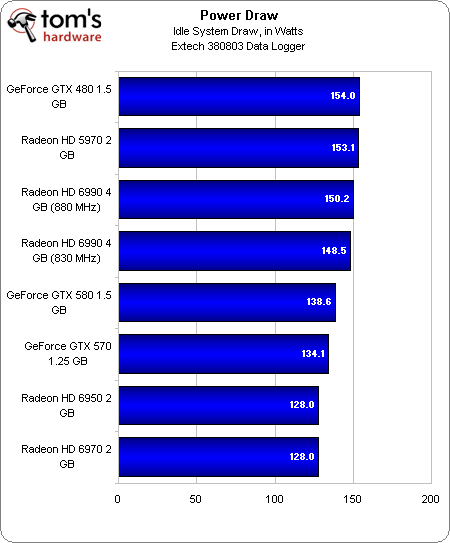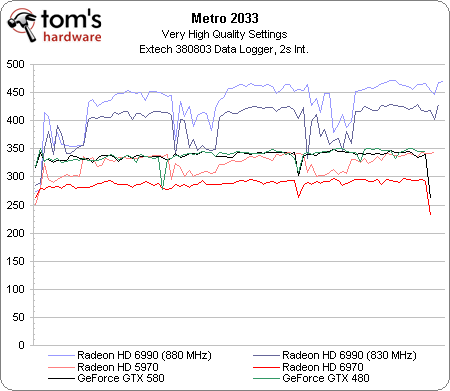AMD Radeon HD 6990 4 GB Review: Antilles Makes (Too Much) Noise
Several months late and supposedly only a couple of weeks ahead of Nvidia's own dual-GPU flagship launch, AMD's Radeon HD 6990 has no trouble establishing performance superiority. But does speed at any cost sacrifice too much of the user experience?
The Big Reveal: Power And Noise
Sitting on the Windows desktop, the dual-GPU Radeon HD 6990 impresses us. It uses less power than a single-GPU GeForce GTX 480 and less than the Radeon HD 5970 2 GB. It takes Nvidia’s reworked GeForce GTX 580 to show us more conservative idle power figures.
The situation changes in a big way when you apply a load. We’re not even talking about maximum power figures here. I’m simply logging three iterations of the built-in Metro 2033 benchmark—something you’d see during everyday game play, rather than a “power bug” like FurMark. On average, the Radeon HD 6990 running with its overclocked BIOS uses 94 W more than a GeForce GTX 480. And the GTX 480 already gets ridiculed for its power consumption!
We’ve seen some elegant high-performance graphics cards from AMD, but this is not one of them. It brute-forces performance like a broadsword through cloth.
So, what does it take to dissipate the heat generated by a 375 W card?
Apparently, it takes a noise chart uglier than sin itself.
The problem is that AMD doesn’t use a graceful ramp. It instead steps fan speed up and down to address thermal demands. As a result, you hear the board’s cooler accelerating and decelerating like an engine when the driver downshifts coming up to a stop light.
This is something Nvidia put a lot of thought into after getting skewered for the GeForce GTX 480. I dissected a GPU-Z log file taken while just sitting on the Just Cause 2 menu screen and came up with the following:
Get Tom's Hardware's best news and in-depth reviews, straight to your inbox.
Up to about 78 degrees Celsius, the Radeon HD 6990's fan spins at about 2180 RPM. We’ll call that the safe zone. Within a minute or so in a 3D application, the warmest GPU heats up to somewhere between 88 and 89 degrees, and the fan cranks up to 2880 RPM. That’s “who played a trick on me and swapped my graphics card out for a GeForce GTX 480?” territory. Both the AMD and Nvidia cards crank out about 51 dB. In order to keep the card at 90 degrees or less, the fan then speeds up to 3600 RPM, or what I call Charlie Sheen F-18 mode.
There’s no excuse for a graphics card to be this loud and, if spinning its cooling fan up to 3600 RPM is the only way to keep the Radeon HD 6990 from overheating, then this product simply isn’t ready for consumption. Because the problem is related to fan speed, there’s a chance an updated firmware could smooth out the way AMD handles heat. Right now, though, there’s no way I’d install one of these things in a gaming machine.
The problem is compounded by the fact that two Radeon HD 6970s in CrossFire top out at 53.1 dB(A) (slightly louder than a single GeForce GTX 480) and two GeForce GTX 570s in SLI max out at 49.1 dB(A)—quieter than a Radeon HD 5970. Both card combinations exhaust all of their air out the back of your chassis, they’re both quieter, and the 6970s, at least, are universally faster.
Current page: The Big Reveal: Power And Noise
Prev Page Benchmark Results: Quad-CrossFire! Next Page Conclusion-
CrazeEAdrian Great job AMD. You need to expect noise and heat when dealing with a card that beasts out that kind of performance, it's part of the territory.Reply -
jprahman This thing is a monster, 375W TDP, 4GB of VRAM! Some people don't even have 4GB of regular RAM in their systems, let alone on their video card.Reply -
one-shot Did I miss the load power draw? I just noticed the idle and noise ratings. It would be informative to see the power draw of Crossfire 6990s and overclocked i7. I see the graph, but a chart with CPU only and GPU only followed by a combination of both would be nice to see.Reply -
anacandor For the people that actually buy this card, i'm sure they'll be able to afford an aftermarket cooler for this thing once they come out...Reply -
cangelini one-shotDid I miss the load power draw? I just noticed the idle and noise ratings. It would be informative to see the power draw of Crossfire 6990s and overclocked i7. I see the graph, but a chart with CPU only and GPU only followed by a combination of both would be nice to see.Reply
We don't have two cards here to test, unfortunately. The logged load results for a single card are on the same page, though! -
bombat1994 things we need to see are this thing water cooled.Reply
and tested at 7680 x 1600
that will see just how well it does.
That thing is an absolute monster of a card.
They really should have made it 32nm. then the power draw would have fallen below 300w and the thing would be cooler.
STILL NICE WORK AMD -
Bigmac80 Pretty fast i wonder if this will be cheaper then 2 GTX 570's or 2 6950's?Reply
But omg this thing is freakin loud. What's the point of having a quite system now with Noctua fans :(



